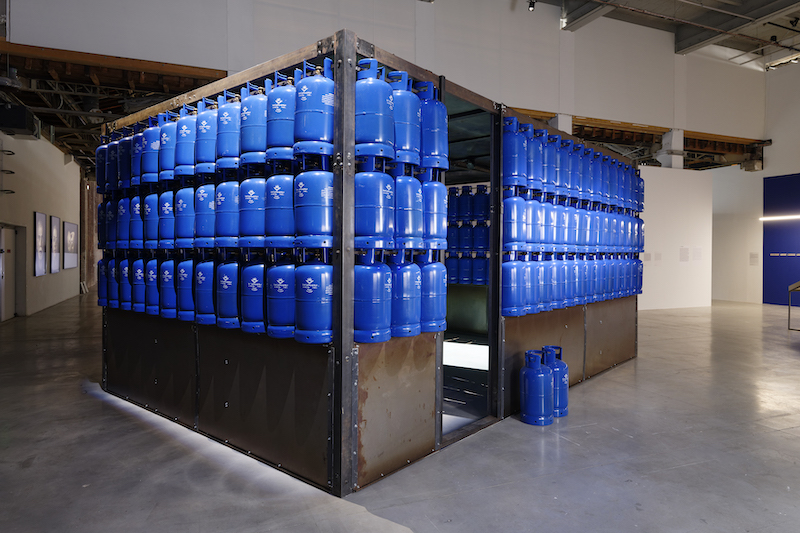A show on the ecological crisis prompts Daisy Sainsbury to question the political role of art
A collaboration with Qatari museum Mathaf, Notre monde brûle (Our World Is Burning) offers an ambitious survey of contemporary art from the Middle East and North Africa. Some 30 artists address three interwoven phenomena: the ecological crisis, the successive sociopolitical crises facing the region and a crisis of history, where traditional narratives are being dismantled and supplanted, not least in artistic practice.
The tone is set by Amal Kenawy’s The Silent Multitudes (2010), an installation that replicates the dimensions of shoebox flats in Cairo’s poorest neighbourhoods. The walls consist of flammable gas cylinders; inside, a video of a gas cylinder being kicked along the pavement underscores the foreboding atmosphere. Created just before the 2011 Egyptian revolution, Kenawy’s work captures the uneasy feeling of imminent upheaval. Shirin Neshat’s Our House Is on Fire (2013), meanwhile, takes us directly to the revolution’s aftermath, with portraits of Egyptians who lost loved ones during the conflict. While powerful, the photographs look almost too beautiful, too aesthetically sanitised alongside Mounira Al Solh’s I strongly believe in our right to be frivolous (2012–), portraits of Syrian refugees sketched alongside handwritten testimonies. Drawn on the lined paper used to process asylum requests, the images feel improvised, the makeshift artistic practice echoing the necessary resourcefulness of displaced people.
Sculptures by American artist Michael Rakowitz, entitled The Invisible Enemy Should Not Exist (2007–), also embed the precarity of the situation they evoke into the substance of the works themselves. After the Fall of Baghdad in 2003, Iraq’s National Museum was looted, and numerous artworks and artefacts destroyed. Using Interpol’s inventory of the missing objects, Rakowitz recreated lifesize replicas assembled from food packaging and Arabic newspapers; these foreground the instability of both cultural heritage and political regimes. This quality reappears in works dealing with environmental themes, such as Khalil El Ghrib’s untitled, undated installation of cardboard, oxidised copper and lichens, depicting the fragile equilibrium of living ecosystems. But while a parallel might be found here between ecological and sociopolitical crises, there are limitations to such comparisons, given the different timescales, geographies and subsequent distribution of responsibility involved.
Francis Alÿs’s contribution contextualises many of the surrounding works by examining the discourses that have arisen around geopolitical conflict. Based on time spent with British troops in Afghanistan’s Helmand Province, his backlit oil paintings on tracing paper resemble maps in military headquarters. Abstracted landmasses in yellow and green are labelled with dialectic couplings: subject/ object, us/them, tourist/migrant. These labels evoke cartography’s colonialist history, the way borders and territories are instrumentalised in nationalist rhetoric, but also the terminology of postcolonial theory and the possibility of challenging dominant discourses and their accompanying ideologies.
When Notre monde brûle was announced, the Palais de Tokyo faced criticism over its collaboration with Qatar’s state-funded museum. LGBTQ+ groups called for the exhibition to be pulled. Given the show accentuates humanist, socially progressive values in curatorial comments and the works included, the discrepancy between these values and those espoused by its funders doesn’t go unmissed. This raises a question about the political role of art institutions and what we expect of them: should exhibition organisers, as members of an institution, take an overt position? Or, as in this instance, is it enough to exhibit works that challenge the political status quo to hint towards art’s capacity to effect change? The answer clearly differs according to the institutions involved, the constraints of their national legal frameworks and the risks they run by taking such a stance. In certain circumstances, an oblique approach may be the only leeway a curator has; in others, an institution’s silence can hang heavy over the show.
Notre monde brûle, Palais de Tokyo, Paris, 21 February – 17 May 2020
From the April 2020 issue of ArtReview
